USS MULLINNIX DD-944
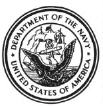 Her First Shake Down
Her First Shake Down
1958
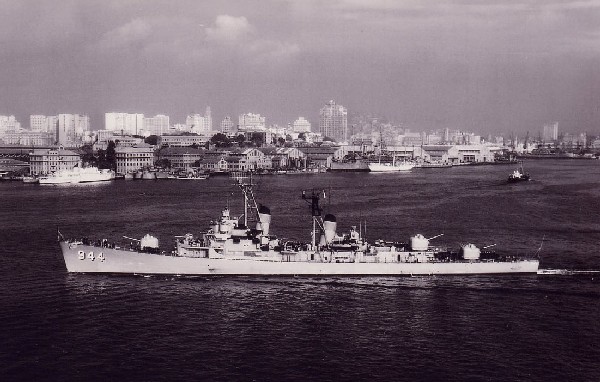
USS Mullinnix DD-944 off the Brazilian Navy Yard, Rio de Janeiro, 14 July 1958
Brazilain warships in the background include (L-R): Jose Bonifacio AGS (far left), Baependi D-17, Sirius H-21, Mariz E Barros D-26,
Duque De Caxias U-11, Bark Guanabara Bocaina D-22, Barrosa Pereira G-16.
1958 Mullinnix Deck Logs (Missing Jan, Feb)
March 1958 (PDF)
April 1958 (PDF)
May 1958 (PDF)
June 1958 (PDF)
July 1958 (PDF)
August 1958 (PDF)
September 1958 (PDF)
October 1958 (PDF)
November 1958 (PDF)
December 1958 (PDF)
Excerpt from "The Last Gun Ship - History of USS Mullinnix DD-944"
A Historical Novel By Frank A. Wood
Enroute to Guantanamo Bay, the ship's crew needed to accomplish two things. The first was to measure the difference between the roller path of the director and each gun. During the shipbuilding process, shipyard machinists machined the guns and gun directors' roller paths close o parallel. However, when the ship was launched and then fully loaded, the hull's resultant twists distorted the required parallelism.
The crew had to calculate the difference and set devices called "roller path compensators" to fool the gun into the director's roller path plane. The crew tried for 4 hours with a telescope centered in the gun's bore aimed at an elevation of minus 1 degree, and the director aimed in the same direction also at minus 1 degree. When the crosshairs in the gun bore crossed the horizon, someone yelled "mark", and then someone else read the director's elevation. After doing this for 36 different directions, the differenced would plot out as a sine wave. No one on board had ever done this before, so Mullinnix got lousy data that looked like chicken scratching.
The CO didn't want to spend any more time on it so, the ship arrived without having any data for our roller path compensators. However, the gunner mates decided if they could get a hold of two gunner's quadrants, they could get the data alongside the pier. As soon as the ship could put someone ashore, they sent for two gunner's quadrants. Two hours later, the ship had the data it needed.
The morning of 9 May, under a brilliant sun, found Mullinnix steaming towards Guantanamo Bay, Cuba to conduct shakedown training operations in accordance with COMDESLANT Serial 0624 of 17 March and orders of COMDESFLOT FOUR. On 10 May, the ship commenced a modified full power trial on two boilers, 2A and 2B achieving 27 knots before experiencing low water in both boilers. The captain stopped all engines immediately and the ship subsequently lost power. After a complete investigation and inspection, there was no apparent damage to either boiler.
With the sighting of Punta Caleta Light and Windard Point Light on 12 May, the crew commenced preparations for entering Gitmo. At 0841, Mullinnix was moored port side to wharf B, US Naval Operating Base, Guantanamo Bay Cuba with USS Ault DD-698, USS Waldron DD-699 and USS Forrest Sherman DD-931 starboard. SOPA was COMDESRON 10 in USS Forrest Sherman DD-931.
Next, the ship needed to complete the system collimation. Collimation ensures that when the director and the gun were looking at the same object, like a star, the sightlines were perfectly parallel.
Again, the standard procedure was to aim the director at a particular star and, using the telescope in the gun bore looking at the same star, then record the train and elevation reading and set another parallax corrector. The one thing that the ship could not control was the weather. A clear sky was required to complete the task. Night after night the skies were cloudy. Rain clouds had sealed the sky and, on the ship's decks the air was hot and almost luminosity with humidity. Mullinnix simply could not align the battery.
This didn't stop the Mullinnix crew on their gunnery exercises. A typical report would read, "outstanding procedures, exercise grade unsatisfactory due to insufficient target triggered bursts." The night before the final exams, the Mount 51 crew gazed past the ship's bow. Ahead on the horizon was a blanket of twinkling white dots layered beneath a clear black sky. Within 30 minutes, the ship had the data required to set the parallax compensators.
Visits to Gitmo generally mean work, drills, exercises, and more work and even more work. 14 May was filled with gunfire support, target designation and acquisition, and radar tracking exercises with the aid of the 255-foot Coast Guard Cutter USCG Escanaba WPG-64. The Escanaba, named after a cutter lost during World War II, served from 1946 to 1974. And USS Interdictor YAGR-13. Interdictor was acquired by the Navy on 10 May 1957, converted to Navy use at Charleston Naval Shipyard, commissioned on 7 April 1958 and command by Lt. Comdr. J. P. Dordahl. She too, was on her maiden shakedown training cruise.
A/S exercises with USS Sea Poacher SS-406 filled the hours of the following morning, successfully surfacing mock enemy sub with Hedgehog rounds and hand grenades. Sea Poacher was a veteran of WWII. During her third patrol in the Kuril Islands area, Sea Poacher torpedoed and sank a Japanese trawler and, four days later, sent two fishing boats to the bottom in a surface attack.
The next day, the training group loaded a launcher and three drones on the fantail, and the ship set out for the operations area. When the ship was on location, the trainers launched their first drone - flying it straight into the water. Same thing with #2 drone. They managed to get the #3 drone in the air, flew it about 5 miles, turned it around, and let Mullinnix shoot at it.
The 5" 54 lit up the drone with its rapid-fire capabilities. When the gun fired the 3rd round, they first round knocked the engine of the drone. The parachute deployed, carry the remaining parts of the drone. The 2nd and 3rd projectiles had a target-triggered burst and hit what was hanging below the parachute. The Mux's evaluation read, "outstanding procedures, unsatisfactory, insufficient target triggered bursts." The rules stated a ship had to shot ten rounds and needed six target-triggered bursts to pass. The CO didn't care.
That afternoon, the crew practice anti-aircraft firing exercises on a towed sleeve, expending 74 rounds of 5" VTNF and 42 VTNF 3" rounds. Even though it was early summer, the wind was cool and smelled of salt and gun powder. With calm seas, USS Shasta AE-6 rearmed Mullinnix while both ships steamed in parallel at 11 knots. The crew was beginning to know Mullinnix and she was beginning to accept them. A partnership was being forged that would yield extraordinary service for both, for years to come. After a long rewarding day, the crew relaxed at Pier A alongside USS Hale DD-642, USS Boston CAG-11 (sporting the active fleet's first Terrier missiles), USS Bass APD-124, and USS Kraus EDD-849.
With much being accomplished, the crew was rewarded with a couple days liberty. This tradition was announced with the familiar, "ow hear this, Now hear this, liberty call for sections 1 and 3 to expire Sunday morning 0700".
Situated 90 kilometers east of Santiago and a few kilometers north of the base, is a quaint little port of the same name – Guantanamo City. The main reason to stop there is to visit the lookout at the American naval base, the last colonial outpost remaining on the island. Or, if you're a thirsty love-starved sailor, 'Gitmo-City' had to offer what the crew was willing to pay for.
For detailed liberty information, go to Liberty Call Guantanamo City 1958
Shakedown continued the following week. While conducting towing exercises with the Escanaba on 20 May, Mullinnix encountered the Russians for the first time in her career. At 1113, the Russian merchant ship Kirovsk, out of Leningrad, passed 1200 yards astern on course 277, speed 15 knots. This brief encountered, required the CO to submit the required reports through channels. The crew wondered what a merchant ship from Leningrad could be carrying this far from home and so close to Cuba. They, along with dozens of other ship's crews, would find out in October, 1962.
While still pondering this rare occurrence, the heavens opened up on the crew. By 1806, visibility was reduced to 700 yards by heavy rain. Raindrops, big silver tears hurling themselves against the superstructure, breaking apart like dried-up baker's dough. While sounding whistle signals and stationing extra lookouts, Mullinnix finally reached her anchor in berth D-41 in six fathoms of water at 1902.
At 0700 on 21 May, Mullinnix was underway, conducting radar navigation exercises in route followed by gunfire support exercises. At 1050, Mullinnix conducted practice approaches, one-on-one, with USS Boston CAG-1.
Boston, the world's first guided-missile cruiser, was recommissioned by New York Shipbuilding Corporation, Camden, NJ on 1 November 1955. Her armament was lethal. As built, she carried 6" belt, 8" turret faces 6-8"/50 in 2 triple turrets; 10-5"/38 in 5 twin mounts; 12-3"50 in 6 twin mounts; and 2 twin-fail Terrier surface-to-air missile launchers. Manned by 1200, she was 673 feet long with a beam of almost 71 feet. Four boilers and engines powered four screws with 120,000 shaft horsepower – capable of 34 knots.
22 May was filled with additional training in the form of Hedgehog calibration firing in an area between the coast of Cuba and Guantanamo Bay OP-AREA #4. Mullinnix planted one sonar-sensitive triplane suspended from a drifting 'peanut' buoy. By 1059 she had completed her firing runs.
ASW exercise followed with USS Kraus EDD-849, USS Balao SS-285 (played the starring role as the 'pink submarine' in the motion picture 'Operation Petticoat'), USS Hunt DD-674, and USS Benham DD-796. Mother Nature temporarily delayed the exercises at 1151 when a rain squall reduced visibility to 1 mile as trees of lighting crackled above Mullinnix and the other service ships, forcing them to disperse into a broad pattern for safety.
Following several days in Gitmo for maintenance and stand-down, Mullinnix continued with day spotting exercises for the 5"/54 battery and A/S attacks on 26 May with USS Sea Poacher SS-406 and USS C. H. Roan DD-853. In the company of USS Shasta AE-6, the crew was kept busy on 27 May with anti-aircraft firing exercises at the expense of a drone, expending 48 rounds of 5" and 96 rounds of 3".
So it went, the pattern repeating, a couple days stand-down, then back to sea for drone firing, anti-submarine, and A/A firing exercises. Followed by ASW, more drone and ASW exercises. Fighting the fog on 11 June while clearing Pier A as the Cuban coast line was smudged into oblivion, she fired several hundred rounds of 5" and 3" ammunition followed by engineering and damage control exercises.
Graduation day, 13 June 1958. Shakedown completed, behind them, never again. "Halle-fuckin'-lujah! Let's get the fuck-out-of-dodge and haul-ass home!"
With 40,715 gallons NSFO (Navy Special Fuel Oil) safely on board, Mullinnix was underway at 1421 for home – Norfolk, Virginia, in accordance with COMDESLANT Notice 03120, serial 0264, of 17 March 1958. At 1437, the crew gave the Fisherman's Point Light a collective 'fuck you’ as they steamed to open water.
The trip home was filled with days of white hot sun that forced heat to rise off the decks, making the horizon look liquid, almost molten, like a painting that was melting. Each evening the sun would set like a molten planet descending into its own smoke. The nights were black, wrinkled in the wind, the Mullinnix bladed by moonlight. She glided through the two and three foot swells like a three dimensional knife through butter. Almost noiseless. The faint whistle of her self-generated 20 knot wind rushing by the ears of the crew, cool to the salt-flecked skin.
Steaming home feels different than other steaming. With water to the horizon in all directions, one would wonder how sailors could tell. They can. An internal compass that all sailors possess alerts the senses that home is forward of the bow and getting closer with each passing minute, with each passing nautical-mile, with each watch stood.
With most of the crew still in their racks, Mullinnix sighted Cape Henry Light bearing 310, distance 18 miles at 0337. Home was within smelling distance – almost. The anchor detail was set at 0520. What? Why so early? Why only the anchor detail? What The Fuck Over? Mullinnix anchored in ammunition anchorage F, Hampton Roads, Virginia at 0705 – a small detail the crew was unaware of, until now. Fuck me! Ammunition Barge YTB-347 came alongside, and for the next three hours the crew took on board 156 hedgehogs, 560 5"/54 projectiles, 560 5"/54 powder cases and 420 rounds of 3"/50 ammunition.
Finally, at 1136 Mullinnix was underway to berth 231, DesSub Piers, Norfolk, Virginia. With the aid of pilot Captain Winder, after doubling all lines, after securing #1 ship's service generator, after securing fires under 1A boiler, and after securing #1 and #2 main engines, she was home. They were home.
To be continued...


Mullinnix  Clips from 1958
Clips from 1958
Courtesy Jack O'Connell & Jim Young
Loading Ammo in Dec 1958 - Jim Young Producer
Loading Ammo in Dec 1958 Before Heading from Boston to Norfolk
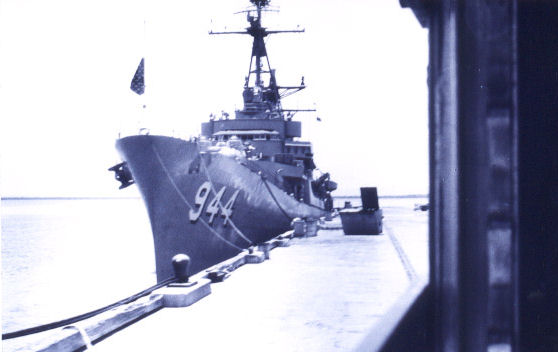
Mullinnix sits at an unknown pier - 1958
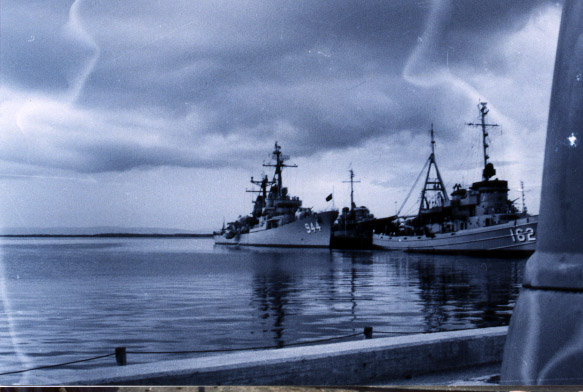
USS Mullinnix DD-944 and USS Compel AM-162 - Unknown Location 1958


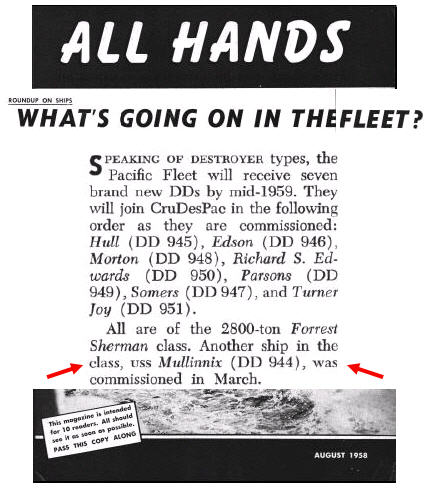
All Hands Magazine, August 1958
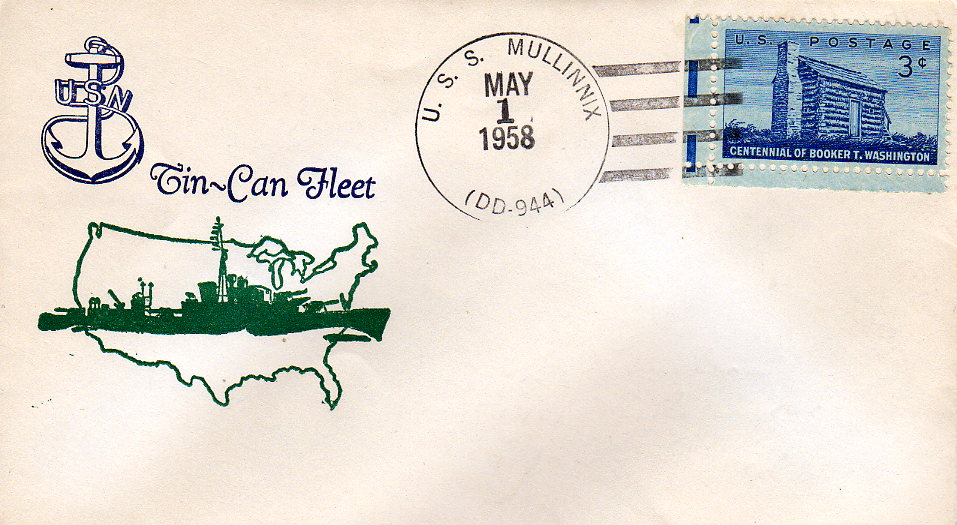
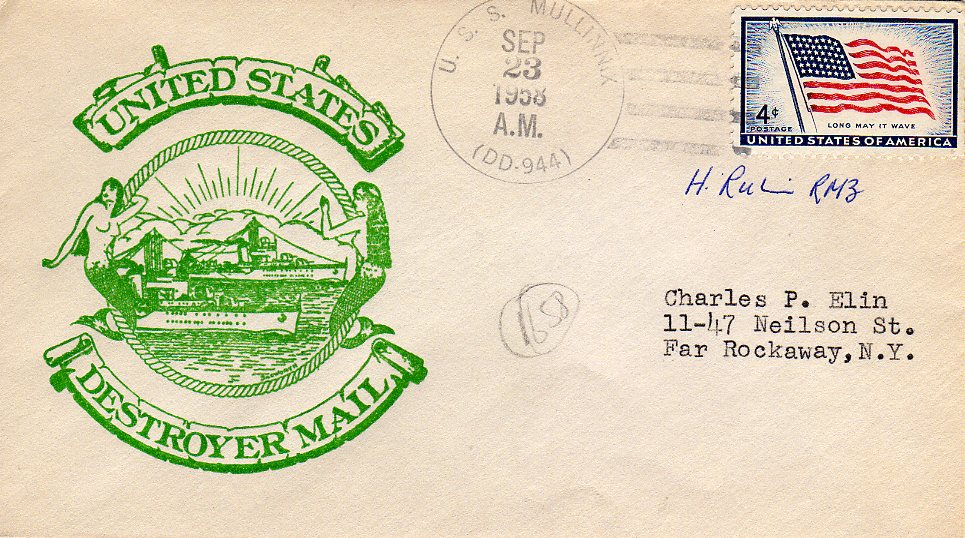
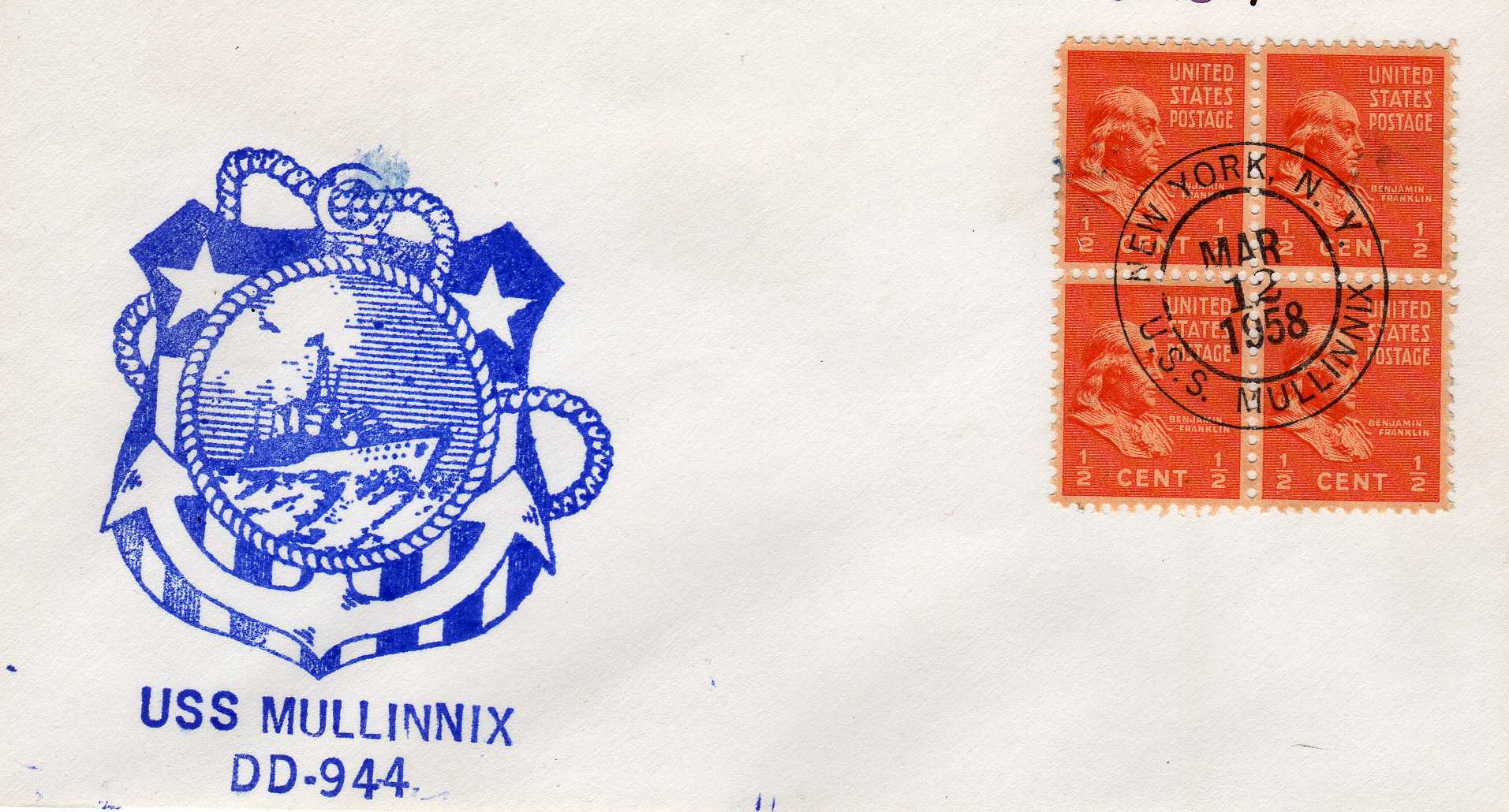
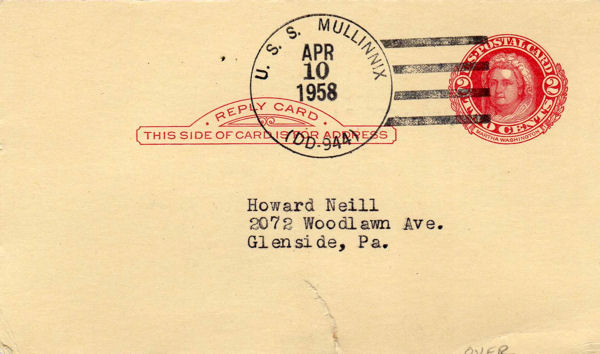
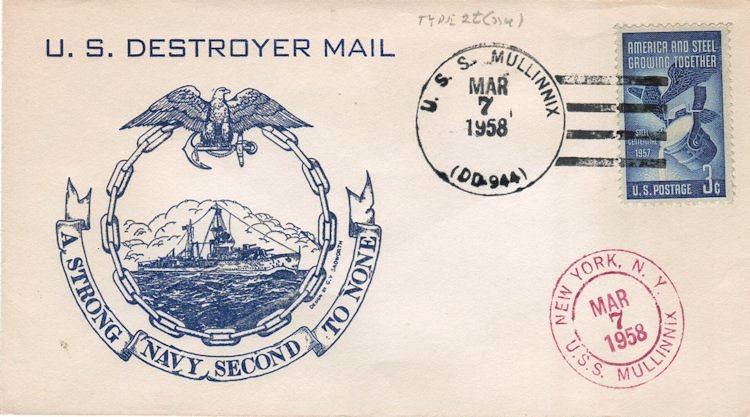
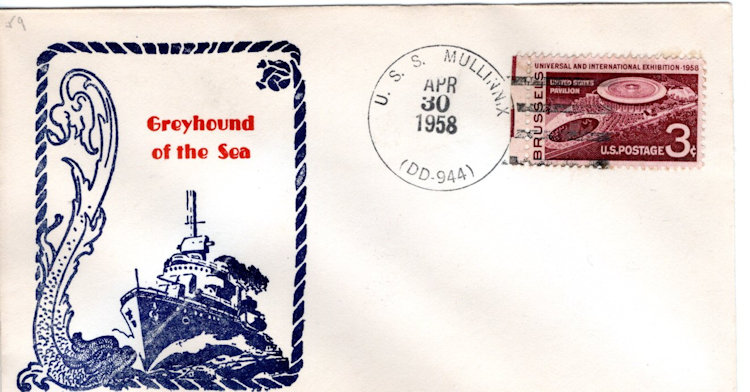
Mullinnix Ship Personnel Diary (PDF)
Courtesy of Jim Young
GO TO 1958 Cruise
GO TO Liberty Call Guantanamo City 1958
Back to Home Port 1958
Back to Ship History
Home
© 2022 by Frank Wood, All rights reserved
 Her First Shake Down
Her First Shake Down Her First Shake Down
Her First Shake Down


 Clips from 1958
Clips from 1958










